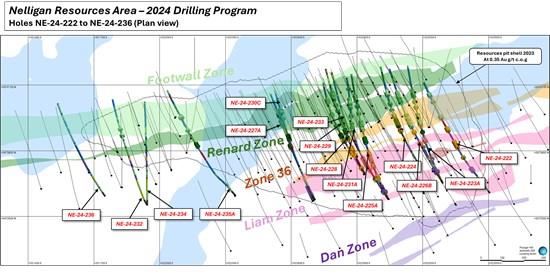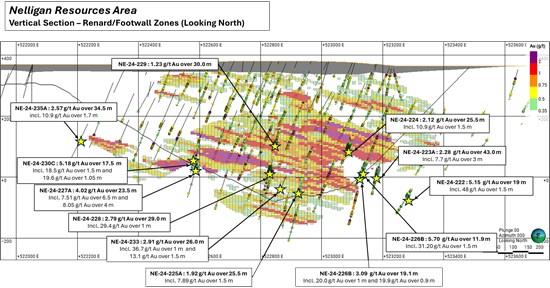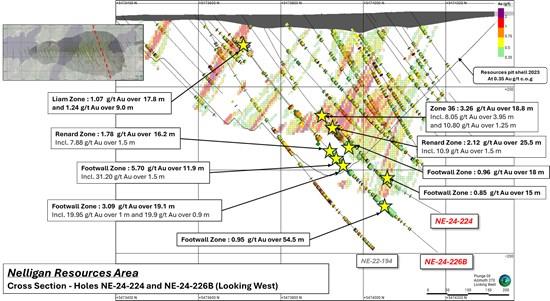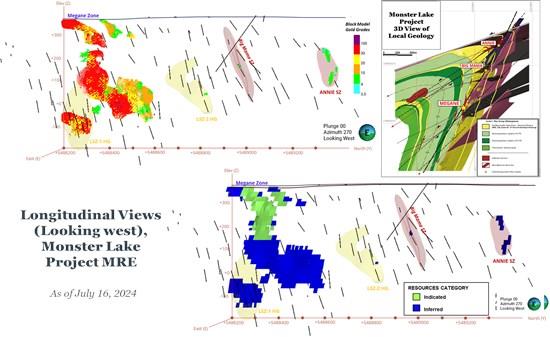IAMGOLD Announces Assay Results From 2024 Nelligan Drilling Program
| ` Mineral Resources Statement – Monster Lake Gold Project as at July 16, 2024 |
|||
| Underground Mineral Resource (at 4,1 g/t Au cut-off) | |||
| Classification | Tonnes | Grade | Ounces |
| (t) | (g/t Au) | (oz Troy Au) | |
| Indicated | 239 000 | 11,0 | 84 200 |
| Inferred | 1 053 000 | 14,4 | 488 500 |
Notes:
(1) These mineral resources are not mineral reserves as they do not have demonstrated economic viability. The MRE follows current CIM Definition Standards (2014) and CIM MRMR Best Practice Guidelines (2019). The results are presented undiluted and are considered to have reasonable prospects for eventual economic extraction (“RPEEE”).
(2) The independent and qualified persons for the mineral resource estimate, as defined by NI 43-101, are Martin Perron, P.Eng., Audrey Lapointe, P.Geo., and Simon Boudreau, P.Eng. (InnovExplo), and the effective date of the estimate is July 16, 2024.
(3) The resource estimate incorporates assay results from 420 diamond drill holes recorded on the entire property and is based on a compilation of historical holes and 161 recent diamond drill holes completed by IAMGOLD, including 51 diamond drill holes (for 17,724 metres) since end of 2017.
(4) The estimation encompasses thirteen (13) lenses and a dilution envelope using LeapFrog Geo and interpolated using Isatis Neo.
(5) 1.0-m composites were calculated within the mineralized zones using the grade of the adjacent material when assayed or a value of zero when not assayed. High-grade capping on composites (supported by statistical analysis) was set between 10.0 and 175.0 g/t Au for high-grade envelopes and 5.0 g/t Au for the dilution envelope.
(6) The estimate was completed using a sub-block model in Isatis Neo, with a parent block size of 5m x 5m x 5m (X,Y,Z) and a sub-block size of 1.25m x 1.25m x 1.25m (X,Y,Z).
(7) Grade interpolation was obtained by the Ordinary Kriging (OK) method using hard boundaries.
(8) Density values of 2.88 to 2.95 g/cm3 were assigned to all mineralized zones.
(9) Mineral resources were classified as Indicated and Inferred. Indicated resources are defined for blocks were estimated if the 3 holes closest to the block have an average distance 30 m, and there is reasonable geological and grade continuity. The inferred category is defined for blocks estimated if the 3 holes closest to the block have an average distance 50 m and if the block was not classified as Indicated and there is reasonable geological and grade continuity.
(10) The MRE is locally constrained and meet the RPEEE requirement by applying constraining volumes to all blocks (selective underground long-hole extraction scenario) using Deswik Mineable Shape Optimizer (DSO).
(11) The RPEEE requirement is satisfied by having a cut-off grade based on reasonable parameters for an underground extraction scenario. The estimate is presented for potential underground scenarios (realized in Deswik) over a minimum width of 2 m for blocks 20 m high by 20 m long at a cut-off grade of 4.1 g/t Au for the long-hole method. Cut-off grades reflect the currently defined geometry and dip of the mineralized envelopes. The underground cut-off grade was calculated using the following parameters: mining cost = CA$150.00/t; processing & transport cost = CA$97.87/t; G&A cost = CA$25.00/t; selling costs = CA$5.00/t; gold price = US$1,800/oz; USD/CAD exchange rate = 1.25 and mill recovery = 94%.
(12) Cut-off grades should be re-evaluated in light of future prevailing market conditions (metal prices, exchange rates, mining costs etc.).
(13) The number of metric tons (tonnes) was rounded to the nearest thousand, following the recommendations in NI 43-101. The metal contents are presented in troy ounces (tonnes x grade / 31.10348) rounded to the nearest hundred. Any discrepancies in the totals are due to rounding effects.
(14) The QPs are not aware of any known environmental, permitting, legal, title-related, taxation, socio-political, or marketing issues or any other relevant issue not reported in the Technical Report that could materially affect the Mineral Resources Estimate.
Next Steps
The resource estimation process has identified a number of areas with potential for resource expansions at depth and along strike in areas where drill hole spacing remains too wide. These areas will be evaluated. The exploration field activities results are continuously compiled to refine the geological and structural model to help identify and prioritize various regional targets developed from targeting exercises to guide future drilling programs.
About the Monster Lake Project
The Monster Lake project is located 50 kilometres southwest of Chibougamau, Quebec, and is underlain by Archean volcanic rocks of the Obatogamau Formation, which are traversed by an important deformation corridor with associated gold-bearing mineralized structures. Exploration to date has traced this prospective structural shear zone system for at least 4 kilometres along strike, along which several gold prospects have been discovered and a Mineral Resource delineated at the 325-Megane Zone.
The Company holds a 100% interest in the Monster Lake project.
Figure 4: Longitudinal sections of the Monster Lake Megane Zone resource block models with gold grade distribution and UG constraining volumes (DSO).
To view an enhanced version of this graphic, please visit:
QUALIFIED PERSON AND TECHNICAL INFORMATION
The drilling results contained in this news release have been prepared in accordance with National Instrument 43-101 Standards of Disclosure for Mineral Projects (“NI 43-101”).
The mineral resource estimate, including verification of the data disclosed, has been completed by InnovExplo Inc., following NI 43-101 and CIM Estimation Best Practice Guidelines. The resource estimate was prepared by Martin Perron, P.Eng. Director Geology, Audrey Lapointe, P.Geo., Senior Geologist and Simon Boudreau, P.Eng., Senior Mining Engineer, all being independent “qualified person”, as defined by NI 43-101 (a “QP”). Each of them has reviewed and approved the contents of this news release.
The QPs responsible for the planning, supervision and execution of the diamond drilling programs and construction of the geological models and review of the technical information in this news release are Shana Dickenson, P. Geo., Senior District Geologist, Adrien Zamparutti P. Geo., Senior Project Geologist, and Maxime Douëllou P. Geo., Project Geologist. Each of Ms. Dickenson, Mr. Zamparutti and Mr. Douëllou is a QP for the purposes of NI 43-101 with respect to the technical information being reported on in this news release. The technical information has been included herein with the consent and prior review of the above noted QPs.
The information in the news release was also reviewed and approved by Marie-France Bugnon, P.Geo. Vice-President, Exploration for IAMGOLD, which is also a QP.
The design of the drilling programs and interpretation of results is under the control of IAMGOLD’s geological staff, including QPs employing strict protocols consistent with NI 43-101 and industry best practices. The sampling of, and assay data from, the drill core is monitored through the implementation of a quality assurance – quality control (QA-QC) program. Drill core (NQ size) is logged and samples are selected by the IAMGOLD geologists and sawn in half with a diamond saw at the project site. Half of the core is retained at the site for reference purposes. Sample intervals may vary from 0.5 to 1.5 metres in length depending on the geological observations. Half-core samples are packaged and transported in sealed bags to ALS Minerals Laboratory (“ALS”) located in Val-d’Or, Québec. A formal chain-of-custody procedure was adopted for security of samples until their delivery at the laboratory. Samples are coarse crushed to a -10 mesh and then a 1,000 gram split is pulverized to 95% passing -150 mesh. ALS processes analytical pulps directly at their facilities located in Val-d’Or which is ISO / IEC 17025 certified by the Standards Council of Canada. Samples are analyzed using a standard fire assay with a 50 gram charge with an Atomic Absorption (AA) finish. For samples that return assay values over 5.0 grams per tonne, another pulp is taken and fire assayed with a gravimetric finish. Core samples showing visible gold or samples which have returned values greater than 10.0 grams per tonne are re-analyzed by pulp metallic analysis. IAMGOLD inserts blanks and certified reference standards in the sample sequence for quality control. In accordance with recommendations from our on-going QA-QC program, additional check analyses are underway at a secondary (umpire) laboratory.
About IAMGOLD
IAMGOLD is an intermediate gold producer and developer based in Canada with operating mines in North America and West Africa. The Company has commenced production at the large-scale, long life Côté Gold Mine in partnership with Sumitomo Metal Mining Co. Ltd., which is expected to be among the largest gold mines in Canada. In addition, the Company has an established portfolio of early stage and advanced exploration projects within high potential mining districts. IAMGOLD employs approximately 3,600 people and is committed to maintaining its culture of accountable mining through high standards of Environmental, Social and Governance practices, including its commitment to strive for the goal of Zero Harm®, in every aspect of its business. IAMGOLD is listed on the New York Stock Exchange (NYSE: IAG) and the Toronto Stock Exchange (TSX: IMG).
CAUTIONARY STATEMENT REGARDING FORWARD-LOOKING INFORMATION
All information included or incorporated by reference in this news release, including any information as to the Company’s vision, strategy, future financial or operating performance and other statements that express management’s expectations or estimates of future performance or impact, including statements in respect of the prospects and/or development of the Company’s projects, other than statements of historical fact, constitutes forward-looking information or forward-looking statements within the meaning of applicable securities laws (collectively referred to herein as “forward-looking statements”) and such forward-looking statements are based on expectations, estimates and projections as of the date of this news release. Forward-looking statements are generally identifiable by the use of words such as “may”, “will”, “should”, “would”, “could”, “continue”, “expect”, “budget”, “aim”, “can”, “focus”, “forecast”, “anticipate”, “estimate”, “believe”, “intend”, “plan”, “schedule”, “guidance”, “outlook”, “potential”, “seek”, “targets”, “cover”, “strategy”, “during”, “ongoing”, “subject to”, “future”, “objectives”, “opportunities”, “committed”, “prospective”, “preliminary”, “likely”, “progress”, “strive”, “sustain”, “effort”, “extend”, “on track”, “remain”, “pursue”, “predict”, or “project” or the negative of these words or other variations on these words or comparable terminology.
For example, forward-looking statements include, but are not limited to, statements with respect to: the estimation of mineral reserves and mineral resources and the realization of such estimates; operational and financial performance including the Company’s guidance for and actual results of production, ESG (including environmental) performance, costs and capital and other expenditures such as exploration and including depreciation expense and effective tax rate; the updated life-of-mine plan, ramp-up assumptions and other project metrics including operating costs in respect to the Côté Gold Mine; expected production of the Côté Gold Mine, expected benefits from the operational improvements and de-risking strategies implemented or to be implemented by the Company; mine development activities; the Company’s capital allocation and liquidity; the announced intention to repurchase the Transferred Interests in the Côté Gold Mine, the composition of the Company’s portfolio of assets including its operating mines, development and exploration projects; the completion of the sale of the Bambouk Assets; permitting timelines and the expected receipt of permits; inflation, including global inflation and inflationary pressures; global supply chain constraints; environmental verification, biodiversity and social development projects; plans, targets, proposals and strategies with respect to sustainability, including third party data on which the Company relies, and their implementation; commitments with respect to sustainability and the impact thereof, including the Company’s “Zero Harm” vision; commitments with respect to greenhouse gas emissions and decarbonization initiatives (eg. interim target of achieving 30% absolute reduction in Scope 1 and 2 emissions by 2030); the development of the Company’s Water Management Standard; commitments with respect to biodiversity; commitments related to social performance, including commitments in furtherance of Indigenous relations; the ability to secure alternative sources of consumables of comparable quality and on reasonable terms; workforce and contractor availability, labour costs and other labour impacts; the impacts of weather; the future price of gold and other commodities; foreign exchange rates and currency fluctuations; financial instruments; hedging strategies; impairment assessments and assets carrying values estimates; safety and security concerns in the jurisdictions in which the Company operates and the impact thereof on the Company’s operational and financial performance and financial condition; and government regulation of mining operations (including the Competition Act and the regulations associated with the fight against climate change).
The Company cautions the reader that forward-looking statements are necessarily based upon a number of estimates and assumptions that, while considered reasonable by management, are inherently subject to significant business, financial, operational and other risks, uncertainties, contingencies and other factors, including those described below, which could cause actual results, performance or achievements of the Company to be materially different from results, performance or achievements expressed or implied by such forward-looking statements and, as such, undue reliance must not be placed on them. Forward-looking statements are also based on numerous material factors and assumptions, including as described in this news release, including with respect to: the Company’s present and future business strategies; operations performance within expected ranges; anticipated future production and cash flows; local and global economic conditions and the environment in which the Company will operate in the future; the price of precious metals, other minerals and key commodities; projected mineral grades; international exchanges rates; anticipated capital and operating costs; the availability and timing of required governmental and other approvals for the construction of the Company’s projects.
Risks, uncertainties, contingencies and other factors that could cause actual results, performance or achievements of the Company to be materially different from results, performance or achievements expressed or implied by such forward-looking statements include, without limitation: the ability of the Company to complete the repurchase of the Transferred Interest in the Côté Gold Mine; the ability of the Company to complete the sales of the remaining Bambouk Assets; the Company’s business strategies and its ability to execute thereon; the ability of the Company to complete pending transactions; the development and execution of implementing strategies to meet the Company’s sustainability vision and targets; security risks, including civil unrest, war or terrorism and disruptions to the Company’s supply chain and transit routes as a result of such security risks, particularly in Burkina Faso and the Sahel region surrounding the Company’s Essakane mine; the availability of labour and qualified contractors; the availability of key inputs for the Company’s operations and disruptions in global supply chains; the volatility of the Company’s securities; litigation; contests over title to properties, particularly title to undeveloped properties; mine closure and rehabilitation risks; management of certain of the Company’s assets by other companies or joint venture partners; the lack of availability of insurance covering all of the risks associated with a mining company’s operations; unexpected geological conditions; competition and consolidation in the mining sector; the profitability of the Company being highly dependent on the condition and results of the mining industry as a whole, and the gold mining industry in particular; changes in the global prices for gold, and commodities used in the operation of the Company’s business (included, but not limited to diesel, fuel oil and electricity); legal, litigation, legislative, political or economic risks and new developments in the jurisdictions in which the Company carries on business; changes in taxes, including mining tax regimes; the failure to obtain in a timely manner from authorities key permits, authorizations or approvals necessary for transactions, exploration, development or operation, operating or technical difficulties in connection with mining or development activities, including geotechnical difficulties and major equipment failure; the inability of the Company to participate in any gold price increase above the cap in any collar transaction entered into in conjunction with certain gold sale prepayment arrangements; the availability of capital; the level of liquidity and capital resources; access to capital markets and financing; the Company’s level of indebtedness; the Company’s ability to satisfy covenants under its credit facilities; changes in interest rates; adverse changes in the Company’s credit rating; the Company’s choices in capital allocation; effectiveness of the Company’s ongoing cost containment efforts; the Company’s ability to execute on de-risking activities and measures to improve operations; availability of specific assets to meet contractual obligations; risks related to third-party contractors, including reduced control over aspects of the Company’s operations and/or the failure and/or the effectiveness of contractors to perform; risks arising from holding derivative instruments; changes in U.S. dollar and other currency exchange rates or gold lease rates; capital and currency controls in foreign jurisdictions; assessment of carrying values for the Company’s assets, including the ongoing potential for material impairment and/or write-downs of such assets; the speculative nature of exploration and development, including the risks of diminishing quantities or grades of reserves; the fact that reserves and resources, expected metallurgical recoveries, capital and operating costs are estimates which may require revision; the presence of unfavourable content in ore deposits, including clay and coarse gold; inaccuracies in life of mine plans; failure to meet operational targets; , including but not limited to the ability of the Company to achieve ninety percent (90%) throughput at the Côté Gold Mine by year-end and the ability of the Company to achieve nameplate capacity at the Côté Gold Mine in 2025; equipment malfunctions; information systems security threats and cybersecurity; laws and regulations governing the protection of the environment (including greenhouse gas emission reduction and other decarbonization requirements and the uncertainty surrounding the interpretation of omnibus Bill C-59 and the related amendments to the Competition Act (Canada)); employee relations and labour disputes; the maintenance of tailings storage facilities and the potential for a major spill or failure of the tailings facilities due to uncontrollable events, lack of reliable infrastructure, including access to roads, bridges, power sources and water supplies; physical and regulatory risks related to climate change; unpredictable weather patterns and challenging weather conditions at mine sites; disruptions from weather related events resulting in limited or no productivity such as forest fires, flooding, heavy snowfall, poor air quality, and extreme heat or cold; attraction and retention of key employees and other qualified personnel; availability and increasing costs associated with mining inputs and labour, negotiations with respect to new, reasonable collective labour agreements and/or collective bargaining agreements may not be agreed to; the ability of contractors to timely complete projects on acceptable terms; the relationship with the communities surrounding the Company’s operations and projects; indigenous rights or claims; illegal mining; the potential direct or indirect operational impacts resulting from external factors, including infectious diseases, pandemics, or other public health emergencies; and the inherent risks involved in the exploration, development and mining business generally. Please see the Company’s AIF or Form 40-F available on or for a comprehensive discussion of the risks faced by the Company and which may cause actual results, performance or achievements of the Company to be materially different from results, performance or achievements expressed or implied by forward-looking statements.
Although the Company has attempted to identify important factors that could cause actual results to differ materially from those contained in forward-looking statements, there may be other factors that cause results not to be as anticipated, estimated or intended. The Company disclaims any intention or obligation to update or revise any forward-looking statements whether as a result of new information, future events or otherwise except as required by applicable law.
MENAFN23102024004218003983ID1108810614



